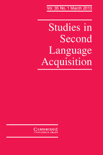
STUDIES IN SECOND LANGUAGE ACQUISITION
Scope & Guideline
Pioneering insights into the art of language acquisition.
Introduction
Aims and Scopes
- Second Language Learning Processes:
Research on cognitive, social, and emotional factors influencing how individuals learn a second language, including the role of working memory, motivation, and anxiety. - Language Production and Comprehension:
Studies exploring the mechanisms of language production and comprehension in second language contexts, including fluency, accuracy, and complexity in both spoken and written forms. - Cross-Linguistic Influence and Transfer:
Investigation into how first language influences the learning and use of a second language, including issues of transfer, interference, and the role of bilingualism. - Task-Based Language Learning and Teaching:
Research focusing on task-based approaches to language learning, examining how different types of tasks affect language outcomes and learner engagement. - Assessment and Measurement in SLA:
Development and validation of assessments for measuring second language proficiency, including various methodologies for evaluating linguistic performance. - Emerging Technologies in Language Learning:
Exploration of how technology, including mobile applications and AI (like ChatGPT), impacts second language acquisition and learner experiences. - Cultural and Sociolinguistic Factors:
Understanding the impact of sociocultural contexts on second language learning, including issues of identity, community, and language use in diverse settings.
Trending and Emerging
- Individual Differences in Language Learning:
A growing body of research focuses on individual differences such as personality traits, learning styles, and cognitive abilities, emphasizing how these factors contribute to language acquisition success. - Neuroscientific Approaches to SLA:
Emerging studies employing neuroimaging and other neuroscientific methods to understand the brain mechanisms involved in language learning, providing insights into cognitive processes during acquisition. - Mobile-Assisted Language Learning (MALL):
Increasing interest in how mobile technologies facilitate language learning, particularly among non-traditional learners, reflecting broader trends in digital education. - Longitudinal Studies of Language Development:
A trend towards longitudinal research designs that track language development over time, allowing for a deeper understanding of the processes and trajectories of second language acquisition. - Task Complexity and Cognitive Load:
Research examining the effects of task complexity and cognitive load on language learning outcomes, informing pedagogical practices and task design in language education. - Social and Emotional Factors in SLA:
An emerging focus on the social and emotional dimensions of language learning, including the impact of anxiety, motivation, and learner identity on acquisition outcomes.
Declining or Waning
- Traditional Grammar Instruction:
Research focusing solely on traditional grammar instruction methods is less prevalent, as the field shifts towards more communicative and contextualized approaches to language learning. - Static Models of Language Learning:
There is a noticeable decline in studies that propose static models of language learning, with a growing emphasis on dynamic and complex systems perspectives. - Age-Related Studies in Isolation:
Research examining age-related factors in a vacuum is becoming less common, as newer studies increasingly consider the interplay of multiple factors, such as motivation and cognitive abilities. - Focus on Vocabulary Acquisition Alone:
While vocabulary remains important, there is a reduced emphasis on isolated vocabulary acquisition studies, with more research integrating vocabulary into broader language use and interaction contexts. - Overemphasis on Quantitative Research:
The journal is moving away from an overreliance on quantitative methods alone, integrating more qualitative and mixed-method approaches to provide richer insights into language acquisition.
Similar Journals
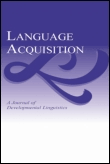
Language Acquisition
Shaping the future of linguistics and educational psychology.Language Acquisition, published by ROUTLEDGE JOURNALS, TAYLOR & FRANCIS LTD, is a leading academic journal dedicated to the interdisciplinary study of language development and acquisition. With an ISSN of 1048-9223 and E-ISSN 1532-7817, this peer-reviewed journal caters to professionals, researchers, and graduate students in the fields of linguistics and educational psychology. The journal boasts an impressive 2023 Scopus ranking of Q1 in Linguistics and Language and Q2 in Education, reflecting its high impact and relevance within academic circles. Notably, it is indexed among the top 15% of journals in Language and Linguistics, showcasing its significance in contributing knowledge to these vibrant fields. Although currently not open access, Language Acquisition makes a profound impact on understanding how individuals acquire language, facilitating discussions on pedagogical strategies, cognitive development, and sociolinguistic factors. The journal's historical and ongoing contributions since its inception in 1990 reinforce its position as a vital resource for advancing research and theory related to language acquisition.
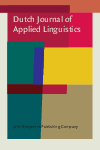
Dutch Journal of Applied Linguistics
Exploring Innovations in Language Use and LearningWelcome to the Dutch Journal of Applied Linguistics, a premier open-access publication dedicated to advancing the field of applied linguistics. Published by openjournals.nl and based in the Netherlands, this journal has been committed to disseminating innovative research since its inception in 2012, gaining recognition within the academic community for its rigorous scholarship and high standard of publications. With an impressive Q1 ranking in both the Linguistics and Language category and a commendable percentile standing in Scopus, the journal provides an essential platform for researchers, professionals, and students alike to explore the latest findings and developments in language studies. As an open-access journal since 2021, it ensures that valuable knowledge is freely accessible to a worldwide audience, fostering collaboration and enhancing the impact of research in this dynamic field. The Dutch Journal of Applied Linguistics invites you to contribute and engage with cutting-edge scholarship that shapes the future of language use and learning.

Revista Espanola de Linguistica Aplicada
Exploring innovative approaches in applied linguistics.Revista Espanola de Linguistica Aplicada is a prominent academic journal published by John Benjamins Publishing Co, specializing in the interdisciplinary fields of linguistics, education, and e-learning. With its ISSN 0213-2028 and E-ISSN 2254-6774, the journal has established a significant presence in Spain and beyond, showcasing innovative research and contributions in applied linguistics. The journal is recognized for its rigorous peer-review process and maintains impressive Scopus rankings, notably within the 72nd percentile for Arts and Humanities and 68th percentile for Social Sciences, reflecting its critical role in advancing the study of language and education. As of 2023, it holds a Q3 rank in Education and a Q2 rank in Linguistics and Language, underscoring its influence and relevance in these disciplines. Targeted at researchers, educators, and students alike, the journal aims to facilitate knowledge exchange and provide a platform for discussions that shape the future of linguistics.
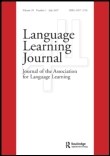
Language Learning Journal
Unveiling the science behind effective language acquisition.Welcome to the Language Learning Journal, a premier resource for researchers, educators, and linguists alike, published by Routledge Journals, Taylor & Francis Ltd. With a proud history dating back to 1990 and commitment to advancing the exploration of language acquisition, this esteemed journal boasts an impressive impact factor within Q1 rankings across both the Education and Linguistics and Language categories. Ranked #40 in Language and Linguistics and achieving a 96th percentile in the Arts and Humanities, the journal serves as a crucial platform for disseminating cutting-edge research, innovative methodologies, and impactful discussions in the field of language learning. Although currently not offered as an open access publication, the depth and quality of content ensure significant contributions to the body of knowledge for professionals and scholars. With its global reach, the Language Learning Journal is dedicated to fostering the development and understanding of language learning processes, enabling readers to stay informed about the latest trends and findings through rigorous peer-reviewed articles.

Reading in a Foreign Language
Unveiling the Science of Second Language LiteracyReading in a Foreign Language is a premier academic journal published by the University of Hawaii, College of Languages, Linguistics & Literature, dedicated to fostering the field of second language acquisition. With an ISSN of 1539-0578, this esteemed journal boasts a solid reputation, being ranked in the Q1 quartile in both Education and Linguistics, highlighting its significant impact within these disciplines. Covering the latest research and advancements from 2019 to 2024, Reading in a Foreign Language serves as an essential resource for educators, researchers, and students aiming to deepen their understanding of reading proficiency in second languages. Although Open Access is not offered, the journal's influential position is underscored by its impressive Scopus rankings, with 82nd percentile status in Linguistics and Language, and 52nd percentile in Education, making it a valuable asset for those enhancing their academic and professional pursuits in language studies.
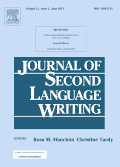
JOURNAL OF SECOND LANGUAGE WRITING
Bridging Theory and Practice in Language EducationJOURNAL OF SECOND LANGUAGE WRITING, an esteemed publication of PERGAMON-ELSEVIER SCIENCE LTD, serves as a pivotal resource in the fields of Education and Linguistics, exhibiting a remarkable impact factor that solidifies its standing in the academic community. Established in 1992, this journal has consistently provided a platform for high-quality research and discourse, with its articles rigorously peer-reviewed to ensure scholarly integrity. Holding Q1 rankings in both Education and Linguistics for 2023, it is recognized for its influence in shaping the field of second language acquisition and pedagogy. With impressive Scopus rankings that place it in the 98th percentile among peers, the journal attracts a diverse readership comprising researchers, educators, and students eager to explore the intricacies of second language writing. Its focus encompasses theoretical research, practical applications, and innovative methodologies that enrich the field, making it an essential resource for those dedicated to understanding and enhancing the writing skills of second language learners.
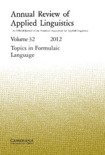
Annual Review of Applied Linguistics
Shaping the future of linguistic research and application.The Annual Review of Applied Linguistics, published by Cambridge University Press, stands as a premier journal in the realm of linguistics and psychology, with an impressive impact factor identifying its significance: ranking in the Q1 quartile across both fields in 2023. With an ISSN of 0267-1905 and an E-ISSN of 1471-6356, this journal endeavors to provide comprehensive and insightful reviews covering an array of topics within applied linguistics, thus supporting researchers, professionals, and students in advancing their understanding and expertise. Operating from its base in Cambridge, United Kingdom, the journal has maintained a consistent commitment to scholarly excellence since its inception, accelerating discussions on critical issues and emerging research trends from 2005 to 2024. Notably, it holds a prestigious position in Scopus, ranked #26 in Language and Linguistics and #30 in Social Sciences, showcasing its influence and contribution to the scholarship in the field. The Annual Review of Applied Linguistics thus stands as an essential resource for anyone engaged in linguistic research and application.
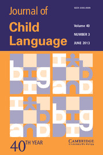
JOURNAL OF CHILD LANGUAGE
Unraveling the Mysteries of Language in Young MindsJOURNAL OF CHILD LANGUAGE, published by Cambridge University Press, is a premier scholarly journal dedicated to the exploration and examination of language development in children. Since its inception in 1974, the journal has become an authoritative source in the fields of Developmental and Educational Psychology, Experimental and Cognitive Psychology, and Linguistics, boasting significant impact as evidenced by its ranking in the top quartiles across these domains. With an impressive impact factor and a commitment to advancing research, the journal serves as a vital platform for researchers, educators, and practitioners interested in the intricacies of language acquisition and cognitive development in children. The 2023 Category Quartiles place it in Q1 for Linguistics and Language, further establishing its excellence. Fostering a rich intellectual community, the journal invites contributions that advance our understanding of child language, promising a broad readership in both the social sciences and humanities.

Journal of Technology and Chinese Language Teaching
Innovating Chinese Teaching in the Digital EraJournal of Technology and Chinese Language Teaching, published by JOURNAL TECHNOLOGY & CHINESE LANGUAGE TEACHING, serves as an influential platform for scholars and practitioners in the intersecting fields of technology, language education, and linguistic research. With an ISSN of 1949-260X, this journal strives to disseminate cutting-edge research and innovative practices aimed at enhancing the teaching and learning of Chinese language through technological advancements. Operated from the United States, it currently occupies valuable quartiles within its categories, showcasing its significance—ranking Q4 in Computer Science Applications, Q3 in Education, and Q2 in Linguistics and Language. As it spans from 2019 to 2024, the journal provides a rich repository for international contributions, fostering a collaborative environment for educators, researchers, and students alike. With both Scopus and HIndex metrics reflecting a solid reputation, the Journal of Technology and Chinese Language Teaching is pivotal for those keen on pushing the boundaries of language instruction in the digital age.
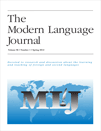
MODERN LANGUAGE JOURNAL
Elevating Scholarly Discourse in Linguistics and Language StudiesThe MODERN LANGUAGE JOURNAL, published by WILEY, stands as a premier academic resource in the field of linguistics and language studies. With its strong legacy dating back to 1916, this journal has evolved to address contemporary issues and trends in language learning, teaching, and research. It holds a prestigious Q1 ranking in both Linguistics and Language categories as of 2023, reflecting its high impact and relevance in scholarly discourse, supported by notable Scopus rankings that place it in the top percentiles of its field. The journal serves as an essential conduit for researchers, educators, and students seeking to contribute to and stay abreast of advancements in language education and linguistic theory. Although it does not currently offer open access options, the journal remains committed to disseminating significant findings that inspire innovative methodologies within the realm of modern languages.